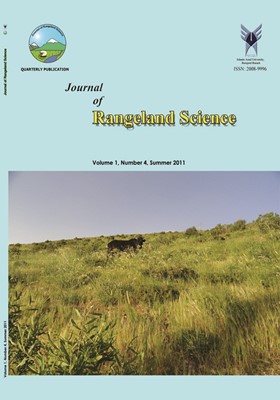Multi-Criteria Evaluation Model for Desertification Hazard Zonation mapping Using GIS (Study Area: Trouti Watershed, Golestan, Iran)
محورهای موضوعی : Relationship between Animal and RangelandArmin Mashayekhan 1 , Farhad Honardoust 2
1 - Forestry, Gorgan University of Agriculture Science and Natural Resources
2 - Arid Zone Management, Gorgan University of Agriculture Science and Natural Resources
کلید واژه: Iran, Fuzzy, Desertification, analytical hierarchy process, Multi-criteria evaluation, Trouti Watershed,
چکیده مقاله :
Desertification is one of the major issues threatening human communities. Manymethods have been developed for assessment and mapping of desertification hazards. In thisresearch, multi-criteria evaluation method was used to investigate desertification process inTrouti watershed, Golestan Province, Iran. At the first step, major desertification factors weredetermined by doing field surveys. They were soil texture, aspect, rainfall, sensitivity ofgeological formation to erosion, hydrologic soil group, slope and land use. The next step,information layers were digitized in GIS environment and Digitized maps were converted tofuzzy standard maps using fuzzy membership functions in IDRISI software. Then, weight ofeach factor was determined with the contribution of Analytical Hierarchy Process. Finally, thesusceptible areas to desertification in the study area were identified using Multi-criteriaevaluation method. The results showed that 36.55, 15.21, 40.17 and 8.07 % of the study areawere classified as severe, high, moderate and slow affected by desertification, respectively. Itwas concluded that land use and sensitivity of geological formations to erosion were the mostimportant factors affecting desertification process in Trouti watershed of Golestan Province.
Ahmadi, H., Abrisham, E., Ekhtesasi,
M.R., Jafari, M. and Golkarian, A. 2005.
Evaluation and mapping of desertification
condition in Fakhrabad- Mehriz region
Using the ICD and MICD models. Jour.
Biaban. 10: 169-187. (In Persian).
Ahmadi, H., Feiznia, S. and Jafari, M.
2004. Investigation of indicators and subindicators of desertification in Iran.
Tehan University. 96 P. (In Persian).
Akbari, M., Karimzadeh, H.R., Modarres,
R and Chakoshi, B. 2007. Assessment
and classification of desertification using
RS & GIS techniques. Iranian Jour.
Range desert Resources. 14: 124-142. (In
Persian).
Babaev, A. G., 1985. Methodological
principals of desertification processes
assessment and mapping. Turkmenistan:
Desert Research Institute, Ashgabat, 72
P.
Chamanpira, Gh., Zehtabian, Gh., and
Ahmadi, H. 2006. Application of ICD
method for determining the severity of
desertification in Koohdasht watershed.
Iranian Jour. Natural Resources, 59:
543-555. (In Persian).
Dafeng, S., Dawson, R., and Baoguo, L.
2006. Agricultural causes of
desertification risk in Minqin, China.
Jour Environ Mana., 79: 348–356.
Ekhtesasi, M.R and Mohajeri, S. 1995.
Iranian classification of desertification
method. 121-134 PP, In Research
institute of Forests and Rangelands,
Proceeding of the second National
Conference of Desertification and
Combating Desertification methods,
Kerman, Iran. (In Persian).
FAO/UNEP., 1984. Provisional
methodology for assessment and mapping
of desertification. Food and Agriculture
Organization of the United Nations,
This is trial version
www.adultpdf.com
Journal of Rangeland Science, 2011, Vol. 1, No. 4 A. Mashayekhan et al. /339
United Nations Environmental
Programme. Rome. 73p.
Kosmas, C., Poesen, J., Briassouli, H.,
1999. Key indicators of desertification at
the Environmentally Sensitive Areas
(ESA) scale. In C. Kosmas, M. Kirkby
and N. Geeson (Eds.), the Medalus
Project: Mediterranean Desertification
and Land Use. Manual on Key Indicators
of Desertification and Mapping
Environmentally Sensitive Areas to
Desertification. Project report. European
Commission.
Rangzan, K., Sulaimani, B., Sarsangi,
A.R., and Abshirini, A. 2008. Change
detection mineralogy, desertification
mapping in East and Northeast of Ahvaz
city, SW Iran using combination of
Remote sensing methods, GIS and ESA
model. Global Jour. environmental
resources, 2: 42-52. (In Persian).
Servaty, M., and Makhtomi, A. 2006.
Evaluation of loess deposits in Jigh
meydan’s watershed. Jour. Geographic
resourcesr, 58: 115-128. (In Persian).
Veron, S.R., Paruelo, J.M. and Oesterheld,
M. 2006. Assessing desertification. Jour
Arid environment, 66: 751-763.
Wang, X.D., Zhong, X.H., Liu, J.G.,
Wang, Z.Y. and Li, M.H. 2008. Regional
assessment of environmental
vulnerability in the Tibetan Plateau. Jour.
Arid environment. 72: 1929-1939.
Wei-dang, W., Cui-ming, X., and Xianggang., D. 2009. Landsli susceptibility
mapping in Guizhou province based on
fuzzy theory. Jour. Minin Science
Technology 19: 399- 404.
Zehtabian. G.H., Ahmadi, H., Ekhtesasi,
M.R. and Jafari, R. 2002. Intensity
determination of wind erosion in Kashan
area by the desertification model. Iranian
Jour. Natural Resources, 55: 145-157.
(In Persain).


